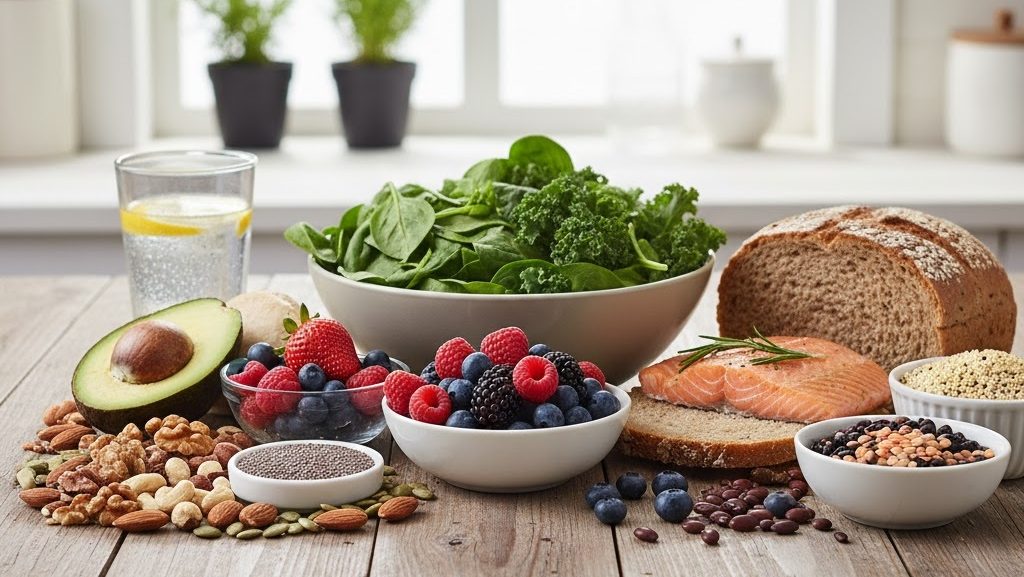Empathetic, evidence-based, and practical — this guide explains which foods science shows can lower your risk of developing type 2 diabetes, why they help, and how to use them in everyday meals.
Why food matters: a short, science-first primer
Type 2 diabetes develops when your body’s insulin production and insulin sensitivity are out of balance. Two powerful levers to shift that balance are body weight and diet quality. Large, long-term human trials show that lifestyle — especially diet plus physical activity and modest weight loss — can dramatically reduce the chance of progressing from prediabetes to type 2 diabetes. In the Diabetes Prevention Program (DPP), an intensive lifestyle program (goal: ~7% weight loss + 150 minutes/week physical activity) lowered diabetes incidence by about 58% compared with placebo. PubMed+1
What foods help? Evidence points to high-fiber plant foods, whole grains, legumes, nuts, fish and olive oil (Mediterranean-style patterns), and limited processed/red meat and refined starches. Several systematic reviews and randomized trials support Mediterranean or plant-forward diets and legume-rich diets in lowering diabetes risk or improving glucose control. PMC+2ScienceDirect+2
How food choices lower diabetes risk — the mechanisms (simple)
- Slow glucose absorption: Fiber and intact grains slow digestion and blunt blood-sugar spikes. (Whole grains & legumes). The Nutrition Source+1
- Improve insulin sensitivity: Diet patterns with healthy fats (olive oil, fatty fish), vegetables, and low ultra-processed foods help cells respond to insulin better. PMC
- Reduce inflammation & lipids: Nuts, olive oil, and plant polyphenols lower chronic inflammation and improve lipid profiles — both linked to metabolic health. PMC
- Promote healthy weight & satiety: High-fiber, protein-rich plant foods and minimally-processed whole foods keep you fuller on fewer calories, helping weight control — key to diabetes prevention. PMC
Top 12 Foods (and food groups) that help prevent type 2 diabetes — quick listicle
- Whole grains (oats, barley, quinoa, brown rice, whole-wheat) — slow-release carbs and fiber. The Nutrition Source
- Legumes & beans (lentils, chickpeas, black beans, soy products like tofu) — fiber + plant protein, low glycemic load. ajcn.nutrition.org+1
- Non-starchy vegetables (leafy greens, cruciferous vegetables like broccoli, peppers) — low energy density, vitamins, phytochemicals. PMC
- Nuts & seeds (almonds, walnuts, flaxseed, chia) — unsaturated fats and fiber; associated with lower diabetes risk in cohort studies. Harvard Health
- Fatty fish (salmon, mackerel, sardines) — omega-3s and improved cardiometabolic markers. PMC
- Olive oil — core of Mediterranean diet; tied to better blood-sugar control and reduced diabetes risk. PMC
- Berries & low-sugar fruits (blueberries, strawberries, apples) — antioxidants and fiber with lower glycemic effect. ScienceDirect
- High-fiber breakfast foods (steel-cut oats, bran cereals, barley) — lower post-meal glucose and improved insulin response. The Nutrition Source
- Vegetable-based proteins (tofu, tempeh, edamame) — plant proteins linked to lower diabetes incidence in some studies. PubMed+1
- Fermented foods (moderation) (yogurt, kefir) — some evidence suggests yogurt may be linked with lower diabetes risk, possibly via gut microbiome effects. ScienceDirect
- Beans-based & whole-food snacks (hummus with veg, roasted chickpeas) — substitute for refined snacks. ajcn.nutrition.org
- Water and unsweetened beverages — avoiding sugar-sweetened drinks is crucial; they are strongly associated with higher diabetes risk. ScienceDirect
Handy table — what to eat, why it helps, and how to include it
| Food / Group | Why it helps (mechanism) | Practical serving suggestions |
|---|---|---|
| Whole grains (oats, barley, quinoa) | Slower carb absorption; more fiber & nutrients. | Replace white bread/rice with whole-grain bread, brown rice, steel-cut oats. |
| Legumes (beans, lentils, chickpeas) | Low glycemic load; high fiber + plant protein. | 1/2–1 cup cooked in salads, soups, stews; swap meat with lentils in Bolognese. |
| Leafy greens & cruciferous veg | Very low-calorie, nutrient-dense, anti-inflammatory phytochemicals. | Add a big salad daily; sauté broccoli with garlic. |
| Nuts & seeds | Unsaturated fats, fiber, satiety; improve lipids. | Handful (20–30 g) daily as snack or salad topping. |
| Olive oil & fatty fish | Healthy fats improve insulin sensitivity and inflammation. | Use olive oil for dressings; 2 servings fatty fish/week. |
| Berries & whole fruit | Fiber, lower glycemic response than juices. | ½–1 cup berries as dessert or with yogurt. |
| Yogurt (unsweetened) | May benefit gut microbiome and glucose control. | Plain Greek yogurt + fresh fruit and nuts. |
| Water, tea, coffee (no sugar) | Avoids sugar-sweetened drinks linked to increased diabetes risk. | Replace soda/juice with water, unsweetened tea/black coffee. |
(Table sources and summaries: Harvard T.H. Chan Nutrition Source, Mediterranean diet and diabetes reviews, meta-analyses of legumes & fiber). The Nutrition Source+2PMC+2
Foods to limit or avoid (clear, actionable guidance)
- Sugar-sweetened beverages (soda, fruit drinks): strongly linked to higher diabetes risk. ScienceDirect
- Highly processed snacks & refined carbs (white bread, pastries, many packaged breakfast cereals): they spike blood sugar and are calorie-dense. The Nutrition Source
- Processed and high intake of red meat (bacon, sausages, ham): large cohort studies link processed meat with increased diabetes risk. Recent large analyses also highlight this risk. The Guardian
- Frequent fried foods (especially French fries) — preparation matters: fried potato products have been associated with higher diabetes risk vs. boiled or baked potatoes. San Francisco Chronicle
Evidence highlights — what universities and major trials say
- Harvard T.H. Chan School of Public Health: Replacing refined grains with whole grains and increasing plant foods is associated with lower diabetes risk because fiber slows glucose absorption and improves insulin sensitivity. The Nutrition Source+1
- Diabetes Prevention Program (DPP) — large randomized controlled trial (U.S.): Lifestyle change (diet + exercise, 7% weight loss) cut progression to type 2 diabetes by ~58% in people with prediabetes. This is powerful proof that diet matters in preventing diabetes. PubMed+1
- Mediterranean diet evidence: Multiple observational studies and trials (including randomized and cohort evidence summarized in reviews) show the Mediterranean-style diet — rich in vegetables, legumes, whole grains, olive oil, nuts, moderate fish — reduces the risk of type 2 diabetes and improves glycemic markers. PMC
- Legumes & fiber: Systematic reviews and recent trials show legumes and higher dietary fiber lower markers of glycemic control (like HbA1c) and may reduce diabetes risk. Newer studies (2024–2025) continue to support legume-enriched diets for metabolic health. ajcn.nutrition.org+1
- Processed meat & certain fried foods: Large population-scale analyses (including recent work across global cohorts) associate processed meat and frequent consumption of fried potatoes with higher diabetes risk — supporting public-health recommendations to limit these foods. The Guardian+1
Practical meal plan ideas (easy swaps & day plan)
Breakfast
- Steel-cut oats topped with berries, a tablespoon of flaxseed, and a small handful of chopped nuts.
Swap: instead of sweetened cereal, choose unsweetened high-fiber oats.
Lunch
- Big salad: mixed leafy greens, quinoa or farro, chickpeas, cherry tomatoes, diced cucumber, olives, and olive oil + lemon dressing.
Swap: replace processed deli meat with grilled salmon or marinated tofu.
Snack
- Plain Greek yogurt with cinnamon + a few walnuts OR carrot sticks with hummus.
Dinner
- Baked salmon with a side of steamed broccoli and a barley pilaf with lentils.
Swap: instead of fries or mashed potatoes with butter, pick a whole-grain side and extra veggies.
Dessert
- Fresh fruit (apple slices or berries) or a square of dark chocolate (minimal, <30g) — moderation matters.
Shopping list for diabetes-prevention-friendly pantry
- Steel-cut oats, barley, quinoa, brown rice
- Lentils, canned/ dried beans (black, kidney, chickpeas)
- Extra-virgin olive oil, vinegars, herbs & spices
- Nuts (almonds, walnuts) & seeds (flax, chia)
- Canned tuna/salmon or frozen fatty fish fillets
- Tofu/tempeh, unsweetened plain yogurt
- Fresh or frozen berries, apples, citrus fruits
- Leafy greens (spinach, kale), broccoli, peppers, carrots
Common myths — quick fact checks
Myth: “Carbs cause diabetes.”
Fact: Not all carbs are equal. Highly refined carbs cause rapid glucose spikes and raise risk when consumed chronically. Whole-food carbohydrates (whole grains, legumes, vegetables) are protective because of fiber and nutrient content. The Nutrition Source
Myth: “You must go zero-carb to prevent diabetes.”
Fact: Extremely low-carb diets can improve glucose for some people, but sustainable prevention focuses on quality of carbs (whole and fiber-rich), healthy fats, and calorie balance. The evidence for population-level prevention best supports plant-forward, whole-food patterns (Mediterranean, DASH, plant-based). PMC+1
What the research says about amounts & frequency
- Fiber goal: Many experts recommend 25–38 grams/day of fiber (women/men ranges) with higher intakes linked to lower diabetes risk. Choose mostly from whole foods: whole grains, legumes, fruit, vegetables, nuts. The Nutrition Source+1
- Fish: Aim for 2 servings of fatty fish per week (as in Mediterranean patterns). PMC
- Nuts: A small daily handful (~20–30 g) is supported by cohort studies for metabolic benefit. Harvard Health
- Limit processed meat & sugary drinks: The less, the better — population studies show even modest habitual intakes of processed meats and sugary beverages increase diabetes risk. The Guardian+1
How to use this guidance safely (and when to see a clinician)
- If you have prediabetes or significant family history, talk with a healthcare provider or a registered dietitian before major changes — especially if you’re on medications that affect blood sugar. The DPP-style lifestyle program often works best with professional support. PMC
- If you take glucose-lowering medication, changes in diet or activity can affect doses — coordinate with your clinician.
- For individualized meal planning, an RDN (registered dietitian nutritionist) can translate these patterns into culturally appropriate menus and portion sizes.
FAQs — readers’ most-asked questions
Q: What single food is best to prevent diabetes?
A: There isn’t one magic food. The strongest evidence is for patterns — diets high in whole grains, vegetables, legumes, nuts, and healthy fats (Mediterranean/plant-forward) combined with physical activity and modest weight loss are most protective. PMC+1
Q: How much does sugar cause diabetes?
A: Sugar-sweetened beverages and high added-sugar diets are consistently linked with higher diabetes risk in cohort studies. The effect is largely through excess calories/weight gain and spikes in blood sugar; replacing sugary drinks with water or unsweetened tea lowers risk. ScienceDirect
Q: Are low-carb diets good for prevention?
A: Low-carb diets can improve blood sugar control short-term for some people, but long-term prevention evidence favors sustainable, balanced patterns rich in fiber and plant foods. Individualization matters. PMC
Q: Can eating more fiber reverse prediabetes?
A: Increasing fiber is linked to better glycemic markers (like lower HbA1c) and weight control. While fiber alone may not “reverse” prediabetes for everyone, it is a key part of effective lifestyle interventions shown to prevent progression. Nature+1
Q: Is taking supplements (like cinnamon or chromium) enough to prevent diabetes?
A: Supplements have inconsistent evidence and are not a substitute for dietary patterns shown to work. Focus on whole-food changes first and discuss supplements with a clinician. ScienceDirect



